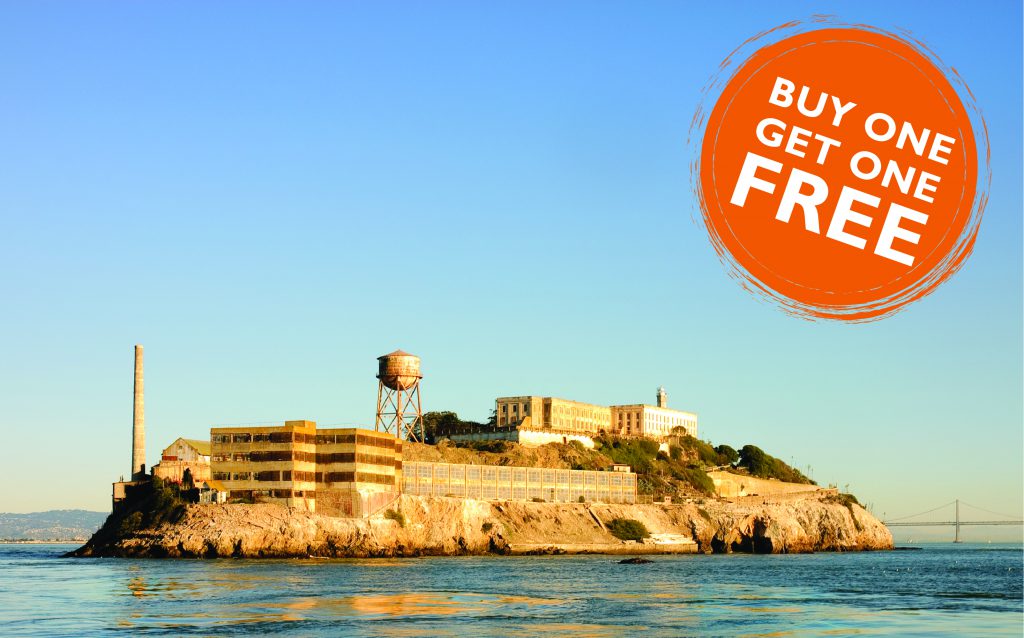Although Alcatraz Cruises’ tours often sell out during the year, it is a priority to educate the community about the robust history of the Island. As a result, Alcatraz Cruises wants to encourage local residents to experience the assets that make Alcatraz Island one of the country’s most visited national parks.
Storia di Alcatraz
"Nonostante quello che dicono, credo che sentano un po' di nostalgia. Penso che sentiranno la mancanza di questo posto". - Fred T. Williamson, direttore di Alcatraz, al momento dell'uscita degli ultimi detenuti nel 1963.
Few islands in the world can boast such a glorious natural setting – and grim human past – as Alcatraz. Visited by Native Americans as early as 10,000 years ago, the barren island remained uninhabited until Europeans arrived. Spanish and Mexican settlers in the early 1800s called the guano-covered island “Isla de los Alcatraces” – Island of Pelicans.
Non molto tempo dopo l'acquisizione dell'isola dal Messico nel 1848, l'esercito americano costruì quello che sarebbe diventato il più grande forte di difesa a ovest del fiume Mississippi durante la Guerra Civile (1861-1865). Alcatraz divenne anche un faro per le navi che entravano nelle acque insidiose del Golden Gate dopo che il suo faro, il primo della costa occidentale, entrò in servizio nel 1854,
Alcatraz began its long era as a dreaded place of confinement when soldier convicts were first imprisoned at the fort in 1860. Over the next decades, the island became less of a defense fort and more of a military prison, with Army convicts building most of the structures still standing on Alcatraz today.
Alcatraz was reborn as a civilian Federal Penitentiary in 1934, becoming known in the press as “The Rock” and “America’s Devil’s Island.” Wardens at Atlanta, Leavenworth, and other federal prisons selected their most unruly convicts to transfer there, among them Al Capone and “Machine Gun” Kelly. No less tough and carefully selected were the correctional officers, one for every three prisoners, who were trained to use their wits as well as their muscles when trouble broke out.
Alcatraz was the most escape-proof prison in the nation. Even if a convict could get past the remote-control locks, guard towers, and barbed wire, he had to struggle against swirling tides and icy waters to reach shore. Yet, escape was uppermost on the minds of many inmates. “Alcatraz is becoming a prison of madmen and men half mad,” Al “The Bug” Loomis, a bank robber once incarcerated there, wrote in 1938. “The sustaining hope is escape.”
Nel corso degli anni, gli evasi hanno costruito rozze ali d'acqua e pinne di legno e hanno tentato la nuotata, ma sono annegati o sono stati catturati mentre nuotavano. Nel 1962, il detenuto John Paul Scott divenne il primo e unico evaso del penitenziario a raggiungere la riva di San Francisco. Fu scoperto privo di sensi sulle rocce di Fort Point, viola e tremante con solo i calzini addosso. Troppo debole per continuare, finì per tornare al punto di partenza.
In that same year, Attorney General Robert F. Kennedy announced the phase-out of the prison. Alcatraz was turned over to the General Services Administration as surplus property and most of the inmates were transferred to a new facility in Marion, Ill. Over the next few years, hundreds of proposals were submitted for new uses for the island, including a West Coast version of the Statue of Liberty, a casino resort, and space museum.
In 1969, a group of 300 Native Americans began a 19-month occupation of Alcatraz, claiming rights to the island under an old Sioux Treaty that gave Native Americans the right to homestead unused federal lands. While the Occupation put a media spotlight on Native American issues, the numbers of activists gradually dwindled and Federal marshals removed the last few from the island in June 1971. Each November Native Americans of many tribes return to Alcatraz to hold a sunrise ceremony commemorating the Occupation.
Nel 1972, Alcatraz entrò a far parte della nuova Golden Gate Recreation Area, un'unità del National Park Service. L'anno successivo iniziarono i tour di Alcatraz, che oggi attirano circa 1,7 milioni di visitatori all'anno in un luogo che tanti uomini avevano sognato di non vedere mai più.


